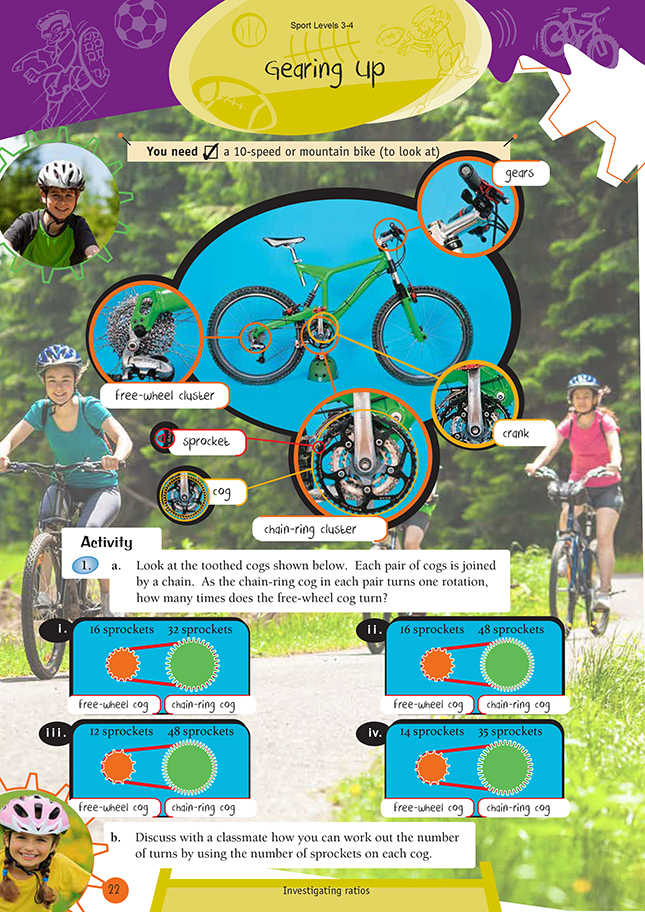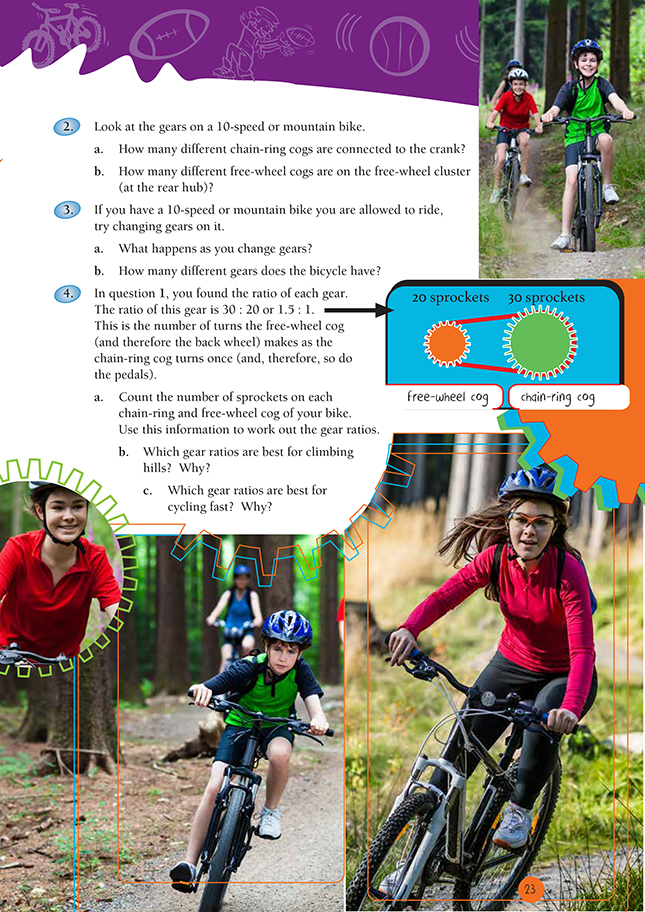This is a level 5 number activity from the Figure It Out theme series.
Click on the image to enlarge it. Click again to close. Download PDF (706 KB)
investigate ratios in bike gears
FIO, Levels 3-4, Theme: Sport, Gearing Up, pages 22-23
A 10 speed or mountain bike (to look at)
Gearing on bikes is an excellent context for students to explore ratio. The general rule for working out the number of rotations is to divide the number of sprockets on the chain-ring cog by the number of sprockets on the free-wheel cog (back wheel). This is because each sprocket on the chain-ring cog is matched by a corresponding sprocket on the free-wheel cog through the links on the chain. So in the case of 1a i, 32 ÷ 16 = 2 gives the number of times the free wheel will rotate for every turn of the chain wheel.
On a 10-speed bike, the 10 gears are created by two different chain-wheel cogs and five different free-wheel cogs. The selectors on the bike allow the chain to slip between these various cogs. This gives 2 x 5 different combinations, that is, 10 different gearing ratios.
The students will find it easier to count the number of sprockets on each wheel of their 10-speed bike if they turn the bike upside down. Using Twink or a similar correction fluid, they can mark one sprocket on each wheel to show where they start counting from. They should use a calculator to work out the ratio divisions because the results often have difficult remainders. Encourage the students to round the decimals in each gear ratio to make them easier to interpret.
In general, the fewer turns the free wheel makes with each rotation of the chain wheel, the easier the bike is to pedal. This requires less effort, which makes low gears ideal for hill climbing. However, biking fast is difficult in low gears. High gears give a lot of turns of the free wheel for each rotation of the chain wheel. Although a lot of effort is needed to rotate the chain wheel, it results in more turns of the free wheel and therefore greater speed.
Answers to Activity
1. a. i. 2 times
ii. 3 times
iii. 4 times
iv. 2.5 times
b. You need to divide the number of sprockets in the chain-ring cog by the number of
sprockets in the free-wheel cog.
2. a. Answers will vary. Teacher to check. (A ten-speed bike has two.)
b. Answers will vary. Teacher to check. (A ten-speed bike has five.)
3. a. The chain moves from cog to cog, at the front or back or both.
b. The number of gears will vary, but you can work this out by multiplying the number of cogs on the crank by the number of cogs on the free-wheel cluster. (With a ten-speed bike, this is 2 x 5 = 10 gears.)
4. a. Answers will vary. Teacher to check
b. Low gears are normally best for climbing hills. In general, the fewer turns the free
wheel makes with each rotation of the chain-ring wheel, the easier the bike is
to pedal.
c. High gears, or those when the chain is around the larger cogs, are best for cycling
fast. High gears give a lot of turns of the free wheel for each rotation of the chainring
wheel. Although a lot of effort is needed to rotate the chain-ring wheel, it
results in more turns of the free wheel and therefore greater speed.

